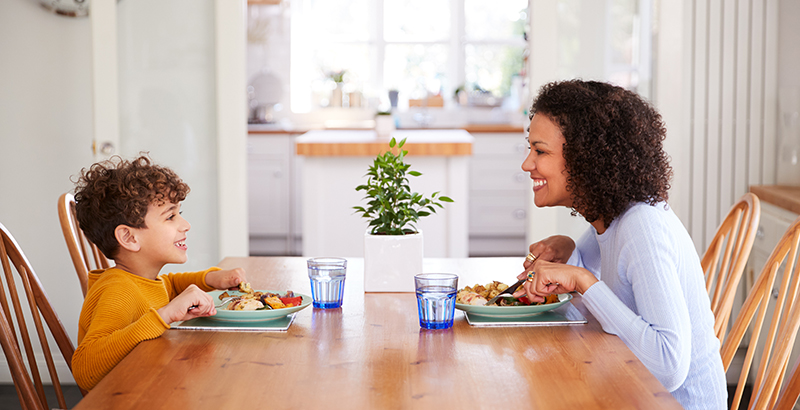74 Interview: SEL Expert Elizabeth Englander on Preserving Social-Emotional Learning During the Pandemic, the Key to Managing Screen Time — and Why Families Should Eat Dinner Together

See previous 74 interviews, including Teaching Lab CEO Sarah Johnson on building relationships during the pandemic, NYC First Lady Chirlane McCray on spreading social-emotional learning to the nation’s mayors and Harvard scholar David Perkins on why the most meaningful learning often takes place outside traditional curriculum. See our full interview archive right here.
As schools continue to grapple with coronavirus outbreaks, displaced students and classroom reopening decisions, much of the focus has been on how educators can help students catch up academically after months of virtual learning and, in many cases, limited interactions with their teachers. But what about students’ social-emotional growth, which could be stunted after months of limited time with peers and stress over the pandemic, economic difficulties and racism?
That question is at the center of work by Elizabeth Englander, a psychology professor and executive director of the Massachusetts Aggression Reduction Center at Bridgewater State University. Her project, “When the Kids Come Back,” offers free resources and advice to help educators meet the challenges of this pandemic school year, with an eye toward social-emotional learning. (She has also co-authored a new book on the topic: The Insanely Awesome Pandemic Playbook: A Humorous Mental Health Guide For Kids)
The 74 spoke with Englander — via Zoom — about how socialization looks different online, what teachers should know about trauma and cyberbullying, and how parents should set limits on screen time.
The interview has been edited for length and clarity.
The 74: I’ve heard you speak about how kids can distinguish between connecting with someone online and building up a relationship over time with someone in person. I imagine that’s going to be a really big challenge for teachers this year, both in building relationships with children and in kids connecting with each other. Can you share more about that research and what that means for education right now?

Englander: The research is an ongoing study that we’ve done since about 2010 with about 5,500 older teenagers. We ask them a lot of questions about their lives and their social function and their school function and their relationships with peers and teachers, parents and families. That particular issue was about drawing a distinction between feeling connected with somebody in the moment when you’re having an interaction with them versus building a really strong and intimate relationship over time. We found that kids understood that there was a difference — but it doesn’t seem like it’s a distinction that many of them had thought about before we asked about it.
To understand what social media’s good for and what it’s not so good for, you have to be aware of that [difference]. A large part of our work in social and emotional learning is raising that awareness. It’s important to draw a distinction between how social media is advertised in the marketplace versus what it actually is good for. And I think it’s promoted as a way of connecting people, and it does, but there are limits to that connection, and in order to be smart and savvy consumers of it, we have to understand what those limits are and teach them to kids.
Do you think there are the same limitations with online learning tools? Is there something similar where you’re connected with your teacher in the moment talking on Google Classroom or another tool, or she’s giving you feedback in an email — but that’s different than seeing a teacher in person every day?
I’m not sure, because with the exception of really small children, I don’t think there’s an expectation with teachers that you’re going to have a really strong personal relationship with students. But there’s sort of a qualitative difference that I haven’t really put my finger on yet. There is something very different about talking to somebody when you’re physically near them than when you’re not.
Right now, if you and I were meeting in a coffee shop, talking at a table, it would feel different. I do a lot of speaking and training in schools, and it feels quite different having somebody who comes in person versus somebody who does it virtually, even though from an objective point of view, you might say, “Why would it feel different? You’re conveying the same information. You can still see each other’s faces.” And yet, there is something different about it. That’s one of the things we’re trying to understand because we want to be able to teach kids about this difference so they can understand it for themselves. To a certain extent, I think they know it, but it’s obviously complicated, or we would have a really easy time with it, which we don’t.
What does this distinction mean for teachers and parents going through the new school year, when there’s a lot more virtual learning than there was before, and there isn’t a close proximity between children and teachers?
School is going to be quite different, and it may be more difficult for students to connect on an emotional level with their teachers. That does have an impact. Children learn best from adults who they’re emotionally attached to. Attachment is not a bad thing in education, even though there has been some movement away from it in recent decades. It’s actually a healthy thing. And the fact that it’s going to be more difficult to achieve in this environment is going to impact how children learn.
I don’t know what it means. Maybe it means we’re going to have to lower our expectations, which I hate the thought of, but it’s possible we’re just not going to make as much progress. I think everybody’s kind of knocking themselves out trying to figure ways around this, but it’s very difficult to teach children online 100 percent of the time.
The good news is that I think parents and students appreciate school and teachers in a way that they haven’t for quite a long time. So, that’s the silver lining, but it’s a pretty tough situation.
What do you mean by lowering expectations?
It’s hard to see how children are going to achieve the same level of social-emotional growth that they would in person. Children are very resilient, and we may find that when kids go back to school, they sort of snap back into shape. We really don’t know. This is a unique situation, and there’s almost no research on this. There’s a little bit of research out of Louisiana on kids who had extended absences following repeated hurricanes. But even that, I think, was three or four months. Now, we’re looking at kids who may be out of school for six months or a year.
It’s really a mess.
You’ve said you haven’t seen much media attention paid to how adults can mitigate the risks of children having been isolated because of the virus. How should we be thinking and talking about those risks, and what should parents and teachers do to mitigate them?
To mitigate the effects of social isolation, we have to seize upon every opportunity for in-person interactions in a way we normally wouldn’t have to. For example, as long as the weather is even a little bit decent, we have got to get kids playing with peers outside, where it’s safe to do that. We’re going to have to teach them to wear masks and socially distance, but they can play outside and be with other kids.
There are also opportunities at home, such as eating dinner together, eating breakfast together, playing board games together, cooking together, cleaning together — anything you can do, you need to bake it into the routine. This can be hard, because in social isolation and in situations where parents are very stressed, because they’re trying to do their job and their kids are trying to do the schoolwork, it’s very stressful and the impulse is to just say, “If I have any flexibility at all, what I want to do is run away. So, if I have any chance to do anything on my own, I’m going to go to my bedroom and do it because I’ve got to have some breathing space.”
But it actually lowers stress a little bit to do things that aren’t high-pressure. For example, eating dinner together is not a high-pressure activity. And in our research, we find kids have better social outcomes when their families eat dinner together. They have more peaceful and better social relationships with their peers if their families eat dinner together. This is true both online and in school. And it was also true, although less so, even if their families didn’t get along.
Now, interacting with family members isn’t the same as interacting with peers. Think back to when you were a kid: Interacting with your family’s relatively easy. They love you. No matter what you do, they like you. With peers, it’s much more challenging. So, family is not the same as peers, but it’s a lot better than nothing. The point is, we have to think about this. We have to say, “Any opportunity I have to have my kids interact with another human being in person, including me, I have to seize on, because they’re getting so little of that.”
We’re hearing so much about what schools should do academically to catch students up when they get back. Are there things that teachers and parents should be doing to catch kids up in social and emotional ways?
There are some teaching techniques that can help and can kill two birds with one stone — that can help the kids academically but also help them socially. For example, assigning the kids to small-group work. When you ask about small-group work, a lot of kids say they hate it. Small-group work with peers is challenging. There’s no doubt about it. But sometimes, that challenge is good for you. It hones your skills. So, while it might not be always fun, it is an academic technique that can help kids socially as well. So, teachers should be thinking about doing things like that or having projects that involve social interactions, such as having students interview people. You want to look for opportunities to give kids that face time as much as possible.
Parents are worrying about academic and social-emotional effects of screen time at a time when even mental health supports might have moved online. What advice do you have?
It’s a very, very hard thing right now. It was hard before, wasn’t it? And the fact that all our interactions have gone online has made it even harder.
I think there are limits to what we can do. Nobody is going to keep up in school on an hour of screen time a day. So, there are practical and functional limits.
What I’ve always thought, even before the pandemic, is that the most productive thing would be to carve out either situations or pockets of time where all agree that you don’t use screens. For example, you could say, “Every day at 5 o’clock, we’re going to cook dinner together, and then we’re going to sit down and eat it together. And that’s going to be a scope of an hour and a half to two hours where we’re not going to use any screens. We’re not going to answer cell phones.” Some people say, “No recreational screen time during the week, or not on weekends, or not on Sundays, or none before 10 a.m., or none after 3 p.m.”
However you want to structure it, it seems like it causes fewer arguments to carve out non-screen time than it does to try to say something like, “Okay, two hours of screen a day, and that’s it.” Because then you sort of get into an endless loop of, what counts? What doesn’t count? Does schoolwork count? If your 12-year-old says, “Mom, I’m reading The New York Times online,” does that count? What about texting? Every text message is about 10 seconds. Are you going to add them all up? It feels like you’re getting yourself into this thing where it requires constant monitoring, constant quarrels.
As a general rule of thumb, I don’t like policies or approaches that increase conflict in families. I think conflict is very damaging for children and families, and for parents too, so I prefer to look for approaches that minimize conflict, even if that means that you might end up doing a little bit more screen time.
But in general, there need to be pockets of time where you’re away from it, where you’re relaxing with a book before you go to sleep or eating dinner with somebody or taking a bike ride or walk. We found generally that kids are very receptive to the idea that screen time is a health issue. They’re a little bit more skeptical about the whole idea of safety. Adults push safety a lot online, and kids feel like they’re savvy and adults are exaggerating dangers. The general approach of saying, “This is an issue of how healthy you want to live” does seem to work better than saying, “There are terrible dangers. And I’m going to warn you about them.”
Are you seeing or hearing about increases in cyberbullying during this time?
I’ve heard anecdotally of it. I don’t think anybody’s published any research on it, so I don’t think we actually know. But anecdotally, we’ve heard, and it kind of makes sense when you have more screen time that you would expect everything to move online a little bit more in that regard. I would be very surprised if we didn’t see some increase. Of course, we’ll see a decrease in bullying in person.
Do you have advice for teachers and parents on handling that and looking out for bullying online?
The ultimate source of information about this are the kids. And if you want to hear from the kids, you can’t just say, “Report, report, report.” What you have to do is build a relationship with them. You have to be interested in their lives. You have to ask them how things are going. And if you build a relationship with them, then you hope that they’ll come and describe to you what’s happening or let you know if they’re in some distress. That’s the goal. But there’s not really a shortcut on this.
Lots of events in the past several months have potentially caused trauma for children, from a deadly virus to an economic crisis to very public violence that we’re seeing against African Americans in the news. Plus, there are personal things like child abuse. What should adults be thinking about going into a new school year to make sure classrooms are trauma-informed and trauma-sensitive?
As part of the “When the Kids Come Back” project, we recommend that a couple of steps should be taken. We have a handout for teachers on trauma — understanding the symptoms, the symptoms that are probable and those that are not very probable. School counselors can send notices to parents saying, “Let me know if your child is struggling emotionally. Let me know if they’re having problems sleeping, problems eating, that kind of thing.” That way, if I’m the school counselor and I know I have this list, say, of 35 kids whose parents say they’re really struggling, I can keep an eye on those kids. I can check in with them. I can make sure they know me and where my office is. They know that they can come see me anytime they want, and that really can really help smooth it.
Also, you want teachers to know how to handle these issues because they are very likely to come up in the classroom. One of the things we did in the project is pull on the research from Louisiana, which suggested that when kids come out of these situations, some of them tend to be talkers. They feel anxious about it, and they want to talk about it. Other kids are completely withdrawn, and talking about it makes them more anxious. So, how do you handle it when you have a class of 25 kids and some of them are talkers and some of them are freaked at the idea of talking?
The answer is you don’t force non-talkers to sit through a classroom discussion. You give talkers other ways that they can express what they’re thinking. You might say to them, for example, “We’re going to journal about what we’ve all been through or what we’re thinking about. And you can go write in your journal, or you can go see the school counselor, or you can hang on knowing that the school counselor’s going to come to our class and we might have a chance to talk about it this afternoon,” something like that. You want to give them an outlet.
It’s really important. There are some kids who are coming back to school, and they have seen people get sick. Some kids have seen people who they know die. Some kids have had parents who’ve lost their jobs. Some kids have had parents who’ve lost their homes. There’s a lot of potential trauma here, and it’s really, really important to be sensitive to that and to understand that. The social-emotional stuff was always important, but this year, it’s really front and center.
Get stories like these delivered straight to your inbox. Sign up for The 74 Newsletter

;)
